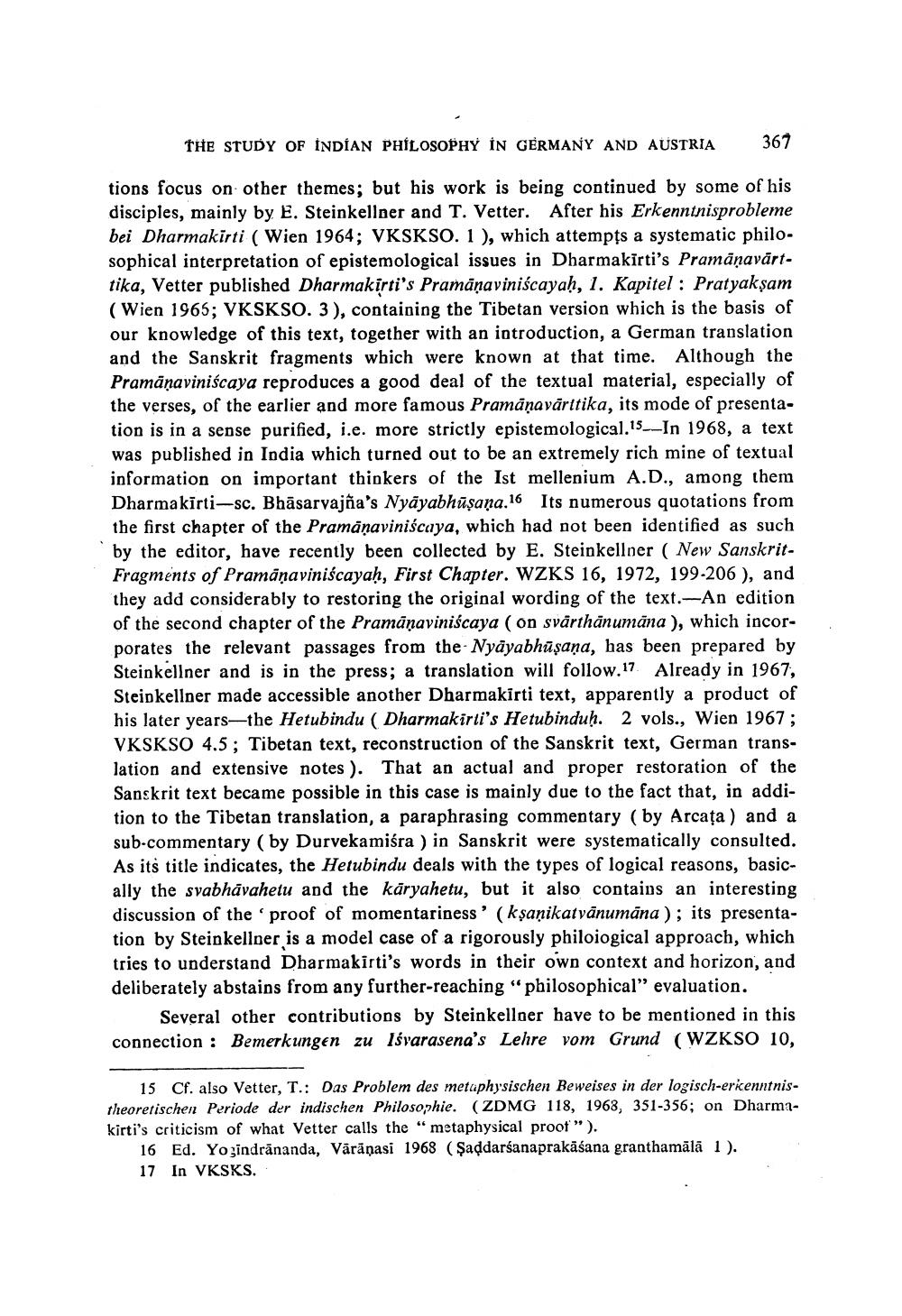________________
THE STUDY OF INDIAN PHILOSOPHY İN GERMANY AND AUSTRIA
367
tions focus on other themes; but his work is being continued by some of his disciples, mainly by E. Steinkellner and T. Vetter. After his Erkenntnisprobleme bei Dharmakirti ( Wien 1964; VKSKSO. 1 ), which attempts a systematic philosophical interpretation of epistemological issues in Dharmakīrti's Pramāņavārttika, Vetter published Dharmakirti's Pramāņaviniscayaḥ, 1. Kapitel : Pratyakşam (Wien 1965; VKSKSO. 3), containing the Tibetan version which is the basis of our knowledge of this text, together with an introduction, a German translation and the Sanskrit fragments which were known at that time. Although the Pramāņaviniścaya reproduces a good deal of the textual material, especially of the verses, of the earlier and more famous Pramāņavārttika, its mode of presentation is in a sense purified, i.e. more strictly epistemological.15.-In 1968, a text was published in India which turned out to be an extremely rich mine of textual information on important thinkers of the Ist mellenium A.D., among them Dharmakirti-sc. Bhāsarvajña's Nyāyabhūşaņa.16 Its numerous quotations from the first chapter of the Pramāņaviniscaya, which had not been identified as such by the editor, have recently been collected by E. Steinkellner ( New SanskritFragments of Pramāņaviniscayaḥ, First Chapter. WZKS 16, 1972, 199-206 ), and they add considerably to restoring the original wording of the text.-An edition of the second chapter of the Pramāņaviniscaya (on svårthānumāna ), which incorporates the relevant passages from the-Nyāyabhūșaņa, has been prepared by Steinkellner and is in the press; a translation will follow.17 Already in 1967, Steinkellner made accessible another Dharmakirti text, apparently a product of his later years—the Hetubindu Dharmakirti's Hetubinduḥ. 2 vols., Wien 1967; VKSKSO 4.5; Tibetan text, reconstruction of the Sanskrit text, German translation and extensive notes). That an actual and proper restoration of the Sanskrit text became possible in this case is mainly due to the fact that, in addition to the Tibetan translation, a paraphrasing commentary (by Arcaţa ) and a sub-commentary (by Durvekamiśra ) in Sanskrit were systematically consulted. As its title indicates, the Hetubindu deals with the types of logical reasons, basically the svabhāvahetu and the kāryahetu, but it also contains an interesting discussion of the proof of momentariness' (kşaņikatvānumāna); its presentation by Steinkellner is a model case of a rigorously philoiogical approach, which tries to understand Dharmakirti's words in their own context and horizon, and deliberately abstains from any further-reaching "philosophical" evaluation.
Several other contributions by Steinkelloer have to be mentioned in this connection : Bemerkungen zu lśvarasena's Lehre vom Grund (WZKSO 10,
15 Cf. also Vetter, T.: Das Problem des metaphysischen Beweises in der logisch-erkenntnistheoretischen Periode der indischen Philosophie. (ZDMG 118, 1968, 351-356; on Dharmakirti's criticism of what Vetter calls the "metaphysical proof").
16 Ed. Yozindrānanda, Värānasi 1968 (Şaddarśanaprakāśana granthamälä 1). 17 In VKSKS.




